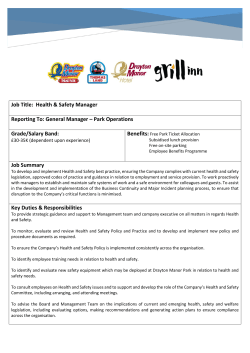
Course Profile Oil and Gas Health, Safety and
Course Profile Oil and Gas Health, Safety and Environment Management in Context (IOG Module 1) This modular course meets the study requirements of Element 1 of the NEBOSH International Technical Certificate in Oil and Gas Operational Safety (IOG) qualification. Course participants who completed all 4 modules would be eligible to register as a candidate for the NEBOSH IOG Examination (please refer to Figure 1 for more information). NEBOSH IOG Certificate shall be issued by NEBOSH UK for candidates who passed the examination. NEBOSH IOG full course is also available. Figure 1 : NEBOSH IOG Modular Courses SAFEHOUSE HSE SDN BHD (1084825-U) Level 23-1, Premier Suite, One Mont Kiara, No. 1, Jalan Kiara, Mont Kiara, 50480 Kuala Lumpur, Malaysia. Tel : +603 2785 6863 Fax : +603 2785 6963 Email : info@safe-house.com.my Web : www.safe-house.com.my Course Profile Who should attend? This flexible modular course is designed specifically for industry specialists with day-to-day safety responsibilities including managers, supervisors and health and safety advisers who are unable to attend the IOG full course on fulltime basis. Learning Outcomes On completion of this element, candidates should be able to demonstrate understanding of the content through the application of knowledge to familiar and unfamiliar situations. In particular they should be able to: • Explain the purpose of and procedures for investigating incidents and how the lessons learnt can be used to improve health and safety in the oil and gas industries • Explain the hazards inherent in oil and gas arising from the extraction, storage and processing of raw materials and products • Outline the risk management techiniques used in the oil and gas industries • Explain the purpose and content of an organisation’s documented evidence to provide a convincing and valid argument that a system is adequately safe in the oil and gas industries. Course Outline 1. Learning from Incidents • Investigating Incidents • Importance of Learning from major incidents 2. Hazards Inherent in Oil and Gas • Terminology • Properties and Hazards of Gases • Properties and Hazards of Associated Products and Control Measures 3. Risk Management Techniques Used in the Oil and Gas Industries • Purposes and Uses of Risk Assessment Techniques • How Risk Management Tools are applied • Industry Related Process Safety Standards • Concept of Hazard Realisation • Concept of Risk Control Barrier Models. • Use of Modeling 4. An Organisation’s Documented Evidence • Examples of Documented Evidence • Where such Documented Evidence is Used • Purpose of Documented Evidence • Typical Content of Safety Cases and Safety Reports SAFEHOUSE HSE SDN BHD (1084825-U) Level 23-1, Premier Suite, One Mont Kiara, No. 1, Jalan Kiara, Mont Kiara, 50480 Kuala Lumpur, Malaysia. Tel : +603 2785 6863 Fax : +603 2785 6963 Email : info@safe-house.com.my Web : www.safe-house.com.my Course Profile Duration 2 days Entry Requirements Although NEBOSH does not set specific formal entry requirements for this qualification, it should be noted that the achievement of the NEBOSH International General Certificate in Occupational Health and Safety (IGC) or equivalent prior to taking this course is highly recommended. This qualification is designed as a specialist sector-specific supplement to the NEBOSH IGC rather than to replace knowledge and understanding of general health and safety gained as part of the IGC. In addition, NEBOSH recommended that students should have a minimum standard of English equivalent to an International English Language Testing System (IELTS) score of 6.0 or higher. For more information, please consult http://www.ielts.org/institutions/test_format_and_results.aspx Certification A Certificate of Attendance will be issued to participant who successfully completed the module. SAFEHOUSE HSE SDN BHD (1084825-U) Level 23-1, Premier Suite, One Mont Kiara, No. 1, Jalan Kiara, Mont Kiara, 50480 Kuala Lumpur, Malaysia. Tel : +603 2785 6863 Fax : +603 2785 6963 Email : info@safe-house.com.my Web : www.safe-house.com.my
© Copyright 2025









